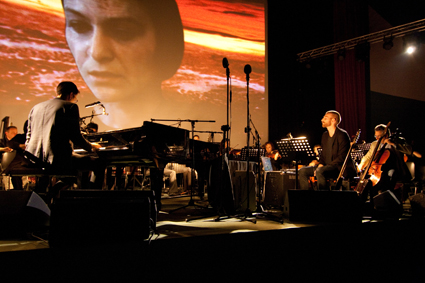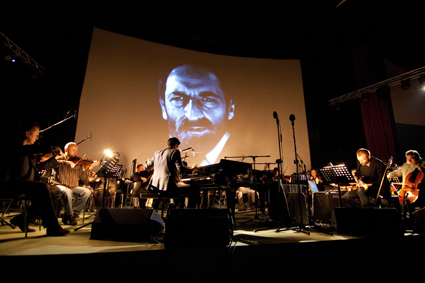 |
Daníel Bjarnason, Ben Frost, Sinfonietta Cracovia, "We don’t need other worlds. We need mirrors." Music for Solaris; Unsound Krakow photo Anna Spysz |
In between touring schedules around Europe’s key music festivals Frost has written sound scores for the Icelandic Dance Company and the UK’s Random Dance as well as Chunky Move’s Mortal Engine. In 2011 Frost is the Rolex Music Protégé under the mentorship of Brian Eno. Coincidentally he has been collaborating with Icelandic composer Daníel Bjarnason, the Sinfonietta Cracovia and Eno on a commission from the Unsound Festival to re-interpret the soundtrack of Andrei Tarkovsky’s mesmerising epic Solaris (1972).
messing with a masterpiece
Frost is happy to admit that he came up with the idea behind Music for Solaris because of his dissatisfaction with Eduard Artemyev’s sound score for the original film. “I don’t dislike the music, I think it’s really beautiful, but it’s a science fiction score. It’s music that’s made to [give you] this feeling that you are in outer space, which in my view is not at all what the actual story is about. The space setting is merely a vehicle to get across a much bigger, more human concept—something that’s much more about inner space.”
Frost feels that Stanislav Lem, author of the novel Solaris, was not completely aware of the humanistic depths of his book, and that it was Tarkovsky’s interpretation that revealed these aspects. He says, “I think that [Tarkovsky] took it to a far more spiritual place. It’s become evident that Lem was pretty dissatisfied with the Tarkovsky version.” It is this element of interpretation or misinterpretation that he feels is the key to his project. “One person can take something from an idea that the person who [instigated it] didn’t actually see themselves and from that you can create all these variations on a theme.”
It’s a deft conceit that frees Frost somewhat from criticism for tinkering with Tarkovsky’s masterpiece. I admire Artemyev’s score for maintaining and heightening the psychological tension while not employing ‘dramatic’ filmic techniques. If Frost’s creation makes it to Australia I’m looking forward to comparing the relationship between the original and its re-interpretation.
finding the language
Frost had been waiting for an opportunity to work with Daníel Bjarnason since they first met in 2002. Bjarnason is a classically trained composer, while Frost has emerged more from the popular electronic end of the music spectrum. Frost describes Bjarnason’s music: “He has a very hardened, quite unromantic aspect to his work that I really appreciate. The thing that I love about his music is the visceral brutality of it. He really stabs you with things. It becomes quite oppressive [but] really dynamic as well.” It has taken until now for the pair to discover a shared language to enable a meaningful collaboration.
The core of that shared language turned out to be improvisation with the basis of the final composition arising from sessions recorded while watching the film, with Bjarnason on heavily prepared piano and Frost on heavily prepared guitars. Frost describes the process: “We did this a few times. There were a lot of moments where we were just sitting in this room watching the film together, but every now and then we’d find things in it, find angles on it and go off into weird little slow jams, ending up with all this material [that] became the basis for the score.”
They then fed the audio files into a computer to generate MIDI data resulting “in all kinds of errors and misinterpretations of that material, which in turn created a whole new set of ideas that were wrong.” However the errors were what Frost was looking for: “I was really interested in the idea of translation and transformation through misinterpretation of information. For me, [this] is what Solaris is about—this idea of missing information. This woman [Hari, who is] being projected back to [Kris Kelvin] is essentially his memory of her. It’s not her in the true sense. So I really liked the idea of working musically that way.”
 |
Daníel Bjarnason, Ben Frost, Sinfonietta Cracovia, "We don’t need other worlds. We need mirrors." Music for Solaris; Unsound Krakow photo Anna Spysz |
establishing equilibrium
The process didn’t end there. Bjarnason and Frost then took this machine translation and retranslated it back into a form humans could play, scoring it for the 30-piece Sinfonietta Cracovia. The reasoning for this third level of interpretation was also inspired by the themes in Solaris. Frost explains, “It’s not so much about the presentation of this being in front of you…it’s what do you do with that information that becomes interesting? That’s the drama of that story: Kris trying to kill Hari three times, eventually giving up and finding some new level of existence through that. Some sort of spiritual equilibrium comes through that process.”
Interestingly, equilibrium has also been reached in the creative partnership of Frost and Bjarnason. Both artists are renowned for their epic compositions but Frost says that Music for Solaris has turned out to be “a very subtle piece of music…It’s almost like phase cancellation—you take two gigantic forces and put them together and you get something that’s not the sum of its parts but actually the negative space that’s created by the two of them.”
mirror images
After this process of re-interpretation, Frost found that he was not so interested in performing the score to Tarkovsky’s original film, so for the visual element of the 50-minute composition he turned to his Rolex mentor Brian Eno (the pair had actually been working on the project prior to the official commencement of the mentorship). Eno, in collaboration with Nick Robertson, chose to mirror the music-making process in some ways. Taking individual frames from the film, they used morphing software to create long, extruded transitions, thus creating new, machine-made material. Frost admits to being rather hands-off on the visual element: “I’ve always struggled with the relationship of video, particularly live video, to music. From my point of view the video is Brian’s thing. I’m really very happy [that there is this] other entity who is approaching the same ideas and material with the same intent but who is essentially oblivious to what I’m doing. We’ve performed it three times now and I don’t get to see the screen a lot, but it’s really quite remarkable how often things happen [together]—the synaesthetic synch of everything is really quite profound.”
"We don’t need other worlds. We need mirrors." Music for Solaris premiered in October 2010 at the Unsound Festival Krakow, with subsequent performances at Unsound New York, The Donau Festival in Austria (of which Frost was also a curator) and most recently in the Reykjavik Festival. With each performance developing it further, Frost admits that the work is “divisive” and requires a lot of its audience due to its slow, quiet intensity.
emotional extremes
Extrapolating from the process of Music for Solaris and his previous albums Steel Wound (Room40), Theory of Machines and By The Throat (Bedroom Community) along with his longstanding ‘band name’ School of Emotional Engineering, I suggest to Frost that he appears preoccupied with the coldness of machines and the quest for deep emotion. He replies, “I think it’s a fascination with extremes: the fascination with dynamics. I want the best of both worlds. My work in the greater sense is increasingly about finding ways to create space between those two things. I think the void is far more interesting than the edges of it. I think that’s probably what drives a lot of these ideas. But then again I’m still working it out.” And, as Ben Frost has only just cleared his 20s, there’ll be plenty of time and opportunities for him to keep chipping away at it. The results so far have certainly been impressive.
Ben Frost has also composed the soundscore for Australian writer-director Julia Leigh’s film debut Sleeping Beauty, premiering at Cannes 2011 and screening at the 2011 Sydney Film Festival. www.sff.org.au/
"We don’t need other worlds. We need mirrors." Music for Solaris, composers, performers Ben Frost, Daníel Bjarnason with Sinfonietta Cracovia, video Brian Eno, Nick Robertson; Unsound Festival Krakow, Poland, Oct 24, 2010; Unsound Festival New York, US, April 6; Donau Festival, Austria, April 29; Reykjavik Arts Festival, Iceland, June 4; www.bedroomcommunity.net/artists/ben_frost
RealTime issue #103 June-July 2011 pg.
© Gail Priest; for permission to reproduce apply to [email protected]








 back
back